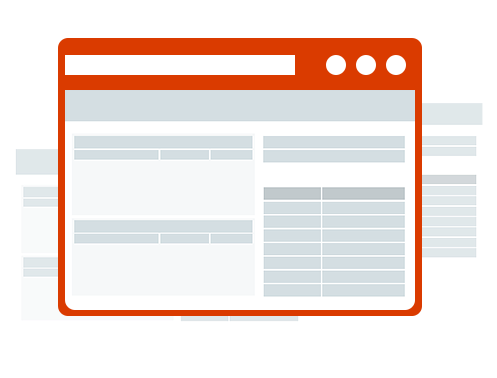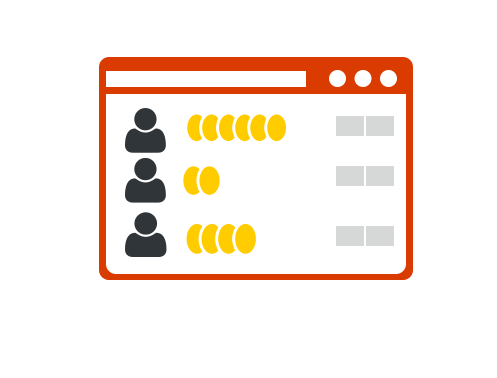GTP - Vulnerability Assessment Service ProviderOur threat & vulnerability assessments gauge the strengths and
weaknesses from every angle to secure your organization
Vulnerability assessment is the process of identifying how vulnerable an infrastructure is to known vulnerabilities—the number one threat to all networks today. The threats/risks found in the vulnerability assessment are ranked and prioritized to expose the current security posture, and to facilitate the remediation process. The first assessment is a baseline snapshot illustrating current threats. The second and subsequent assessments are known as periodic or differential scans, and illustrate trending analysis that answers the question—is our security posture improving over time? Vulnerability Assessment provides you with actionable recommendations. All findings are rated based on risk, probability of exploitation and potential business impact. This allows you to address the issues that matter the most to you. We customize the exploitation and assessment work to your environment and goals. For example, you specify separate instances of critical data that cannot be lost and we attempt to break into the environment and access that data. Our red team can often stealthily break into highly segmented and secure environments and exfiltrate example data.
Vulnerability Assessment Services Overview
Vulnerability Assessment services evaluates the strength of your defenses against the attacks that are most likely to be used by attackers. Our consultants leverage methodologies from our incident response practice to provide the most in-depth and real world scenarios possible. Vulnerability Assessment provides you with actionable recommendations. All findings are rated based on risk, probability of exploitation and potential business impact. This allows you to address the issues that matter the most to you. We customize the exploitation and assessment work to your environment and goals. For example, you specify separate instances of critical data that cannot be lost and we attempt to break into the environment and access that data. Our red team can often stealthily break into highly segmented and secure environments and exfiltrate example data.
The Penetration testing process envolves an active analysis of target system for any potential vulnerabilities that could result from poor or improper system configuration, both known and unknown hardware or software flows, operation weakness will process technical counter measures. It is typicall assessment IT infrastructure, network & business application to identify attack vectors, vulnerabilities & control weaknesses. The best way to know how intruders will actually approach your network is to simulate an attack under controlled conditions. Our Penetration Testing Services team delivers network, application, wireless, and social engineering engagements to demonstrate the security level of your organization's key systems and infrastructure. This simulation of real–world attack vectors documents actual risks posed to your company from the perspective of a motivated attacker. The post–assessment analysis presents logical groupings of one or more security issues with common causes and resolutions as a finding, which allows GTP to quantify and prioritize the business risk to an organization. An actionable findings matrix can be used as an overarching workflow plan that can be tracked within the security organization.
Vulnerability assessment is the process of identifying and quantifying security vulnerabilities in an environment. It is an in-depth evaluation of your information security posture, indicating weaknesses as well as providing the appropriate mitigation procedures required to either eliminate those weaknesses or reduce them to an acceptable level of risk. The threats/risks found in the vulnerability assessment are ranked and prioritized to expose the current security posture, and to facilitate the remediation process. The first assessment is a baseline snapshot illustrating current threats. The second and subsequent assessments are known as periodic or differential scans, and illustrate trending analysis that answers the question—is our security posture improving over time? It is important to understand that vulnerabilities exist across most systems and devices throughout the network. Typical assessments include targets that consist of network devices, operating systems, desktop applications, databases, Web applications, printers and almost any device that is attached to the network. Many organizations have specific assessment requirements. GTP is the source of maintaining security updates as per the Vulnerability Service.
Protecting your enterprise from cyber threats requires constant vigilance over your security infrastructure and critical information assets. Security professionals must review security logs and alerts in real time to identify and thwart malicious activity, while balancing numerous ongoing operational and strategic security tasks. Scalable processes and advanced analysis technology are also key requirements for effective detection and response to threats. GTP Security Monitoring service delivers real-time monitoring, correlation and expert analysis of security activity across your enterprise. This service improves the effectiveness of your security infrastructure by actively analyzing the logs and alerts from network devices in real time, 24x7. Our advanced technology platform provides our certified Security Analysts with the context needed to eliminate false positives and respond to the true threats to your information assets. We ensure information regarding potential security issues is collected, analyzed and reported in a timely manner and proactively identify potential and actual security incidents in order to prevent or detect and address the cause of incidents. Security incident reports are shared with external third parties to increase community awareness of issues.
24x7 real-time security monitoring and protection
The services include incident management, incident escalation, and rapid response to outbreaks. GTP analysts investigate security incidents using advanced query and analysis tools. Analysing security incidents from alert and log data,
GTP acquires a deep understanding of your network environment as it relates to global threat activity.

Application Security
It is critical to test applications at regular intervals, especially after important changes or before launching new applications. Regular application vulnerability assessments will help identify and remediate vulnerabilities and maintain an attacker-resilient web presence. Our extensive portfolio of application security assessments includes: Web and client-server application security assessments, Mobile application assessments across most platforms, Source code reviews for the most common programming languages.

Infrastructure Security
Through hundreds of vulnerability assessments we have identified thousands of critical vulnerabilities that have exposed enterprises to external and internal attacks. Services include: Red-team assessments, External network vulnerability assessments, Internal network vulnerability assessments, Wireless security assessments, Security Project assessments, Network architecture and firewall review, Social engineering, Host and network device review, Custom services as requested. GTP is the No.1 Infosec Company in Bhubaneswar, India.
Vulnerability Assessment Component Services
-

PCI Approved Scanning
-

Device Interrogation & Configuration
-

Minimum Security Baselines
-

External Attack and Penetration

Internal Attack and Penetration
PCI ASV Vulnerability Assessments brings an organizations knowledge of its vulnerabilities from “unknown” to “known.” Without knowing what vulnerabilities are present, it is impossible to remediate or mitigate them. Other benefits include the ability to generate a passing network report to be attested to from an approved PCI ASV Vendor and automatically send approved network reports and Self-Assessment Questionnaire to the organizations Acquiring Bank.

Device Interrogation and Configuration Reviews focus on the fundamental protective mechanisms on the network. Understanding what systems have exposures and incorporating the mitigation efforts can help develop a predefined set of security baselines that can easily be applied throughout the entire organization. Ultimately, this provides confidence that each system is protected and existing exposures are known and understood by the organization.We understand how hackers are attacking systems.

Penetration testing is an effective way of ensuring that successful highly targeted client-side attacks against key members of your staff are minimized. Security should be treated with a holistic approach. Companies only assessing the security of their servers run the risk of being targeted with client-side attacks exploiting vulnerabilities in software like web browsers, pdf readers, etc. It is important to ensure that the patch management processes are working properly updating the Operating System and third party applications.

External Attack and Penetration Assessments must be conducted to achieve compliance with a multitude of regulations and standards that industries face, including the Payment Card Industry Data Security Standard (PCI DSS). Additionally, these assessments detect weaknesses in a system or network that could allow a compromise. They can also be used to test an organizations external monitoring and Incident Response capabilities. GTP team is comprised of nationally renowned ethical hackers.

Internal Attack & Penetration must be conducted to achieve compliance with a multitude of regulations and standards that industries face, including the Payment Card Industry Data Security Standard (PCI DSS). Additionally, this assessment detects weaknesses in a system or network that could allow compromise to a host, while also testing an organization’s internal monitoring and incident response capabilities. GTP team is comprised of nationally renowned ethical hackers.

7 Steps to an Effective Vulnerability Assessment
Identify and Understand your Business Processes.
The first step to providing business context is to identify and understand your organizations business processes, focusing on those that are critical and sensitive in terms of compliance, customer privacy, and competitive position. There is no way for IT to do this in a vacuum.
View All FeaturesPinpoint the Applications and Data
Once the business processes are identified and ranked in terms of mission criticality and sensitivity, the next step is to identify the applications and data on which those mission-critical processes depend. Again, this can be accomplished only through collaboration between IT and other business players.
View All FeaturesFind Hidden Data Sources.
When searching out, make sure that mobile devices such as smartphones & tablets, as well as desktop PCs. Collectively, these devices often contain the most recent, sensitive data your organization possesses. Work with the business units to understand who is using mobile devices for accessing & sharing corporate applications & data.
View All FeaturesDetermine what Hardware Underlies
Continue working down the layers of infrastructure to identify the servers, both virtual and physical, that run your mission-critical applications. Identify the data storage devices that hold the mission-critical & sensitive data used by those applications.
View All FeaturesIdentify which Controls
are already in place.
Note the Security and business continuity measures policies, firewalls, application firewalls, intrusion detection and prevention systems (IDPS), virtual private networks (VPNs), data loss prevention (DLP) & encryption to protect each set of servers and storage devices hosting mission-critical applications & data.
View All FeaturesRun Vulnerability scans.
Only when you’'ve understood & mapped out your application, data flows & the underlying hardware, network infrastructure, & protections does it actually make sense to run your vulnerability scans. Today's attackers are more advanced than any time in modern history. With the growth of world-wide hacking groups, no industry sector is immune from attack.
View All FeaturesApply Business and Technology
Context to scanner results
Your scanner may produce scores of host and other vulnerabilities with severity ratings, it’s important to determine your organizations business and infrastructure context. Deriving meaningful & actionable information about business risk from vulnerability data is a complex and difficult task.
View All Features

